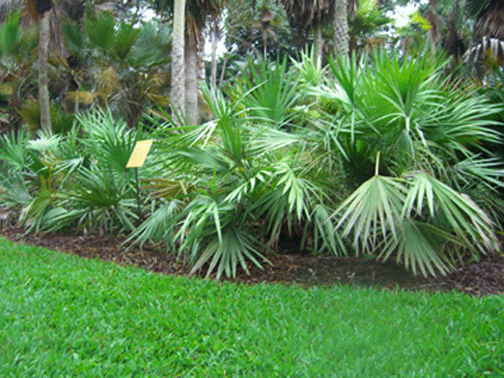Palms are more than Ornamentals

As published in the Miami Herald
Many Floridians love palms because of their beauty and elegance, their capacity to grow fantastically in our South Florida climate and their ability to conjure images of island living. Some Floridians use the impressive royal palm for shade; others use the areca palm as a barrier; while many more plant the saw palmetto for its willingness to grow in any soil. For all of these reasons and more, palm trees make truly remarkable landscape ornamentals. But, there are other incentives in planting palms besides general landscaping. Certain palms attract bees and butterflies, serve as a safe haven for friendly critters and can be a source of food for you and your family.
 |
| Saw palmetto is widely cultivated due to its ease of growth, but has many other benefits. |
Palm trees feed many pollinators: mature pollinators with their nectar, and larva with their leaves. Palms are angiosperms – flower bearing plants. Even though their flowers are very small and the nectar reward can be minimal, they do attract a number of pollinators. Wasps, flies and most importantly for your garden, bees, frequent palm flowers as a welcome change from their standard pollen sources. It is not a rare sight at Fairchild to see bees hovering around stunning Dictyosperma album princess palms in hope of retrieving their rewarding nectar. In other parts of the state, the cabbage palmetto or Sabal palmetto, our state tree, is a popular spot for honey bees during June and July. As long as summer rains don’t interfere, bees gorge on our state tree’s plentiful nectar. Another Florida native, Serenoa repens, or saw palmetto, is one of Florida’s prime nectar sources, producing copious honey crops. The saw palmetto is also the host plant for a myriad of Lepidoptera species. Larva of Batrachedra decoctor, a South Florida native moth, feed solely on the saw palmetto. Many think this larva is a pest, slightly damaging the leaflets of the saw palmetto. But once mature, this small moth plays a vital part in our South Florida ecosystem, feeding many of our native animal species.
Palms help our critter friends in more ways than providing food. They also act as shelter. A plethora of animals are attracted to the safety of palms leaves. Our beautiful native monarch butterflies, along with other butterflies, often take rest on the sturdy, broad leaf of a native thatch palm, Thrinax radiata. Frogs and lizards often hide on the thin stem of a palm leaf, waiting to catch an insect or find a mate. Some of these critters may even eat some of your garden pests in lieu of rent payment. Shy garden snakes often hide in the dead leaves in a palm canopy, waiting until it is quiet to leave her hiding spot and steal a few moments of solitude in the garden. Snakes found in the yard usually feast upon small mammals and other intruders and pose no threat to humans.
 |
| The coconut palm has many uses beyond an ornamental landscape palm. |
Not only do palms help animals, they aid humans, too. The flagship palm is Cocos nuciferus, the coconut palm. The coconut has a multitude of uses: the leaves for weaving and thatching, the trunk for timber and the nuts for fruit and drink. Coconut milk has a wide variety of uses in the food industry and coconut oil in cosmetics. Other lesser known landscape palm edibles include the palm heart of royal palms (Roystonea regia). The fast growth rate of the royal palm makes it one of the top palms for commercial palm heart production. Keep in mind that eating the palm heart will kill the palm tree. Another popular delicacy is eating the newest leaf of the saw palmetto, Serenoa repens. The greener the leaf, the more bitter the taste! The berries of saw palmetto are also eaten as fruit and are manufactured into a prostate medication. Saw palmetto honey is highly coveted and prized by bee farmers. While enjoying palm treats, make sure you know where your palm came from. Pesticides, chemical sprays, and fertilizers are often used on ornamental palms and should not be ingested. If you treat your palms with any sort of chemical, any part of that palm should not be eaten.
Planting a palm because it is beautiful is reason enough to warrant a grove exclusively of palms. They are obviously one of nature’s most handsome gifts. Whether it is a nectar source for hungry bees, a shelter for a lonely tree frog or a delicious snack for your family, palms are a wonderful plant to grow in your backyard. Palms prove the real-life lesson that beauty is only skin deep – their true loveliness lies in the benefits they provide
